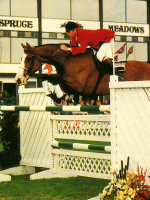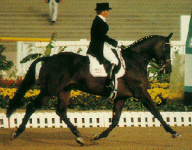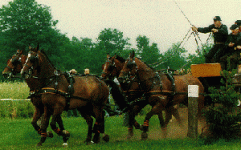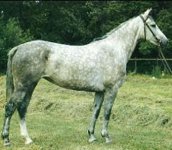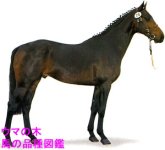♘امیرحسین♞
♘ مدیریت انجمن اسب ایران ♞
The Dutch Warmblood is a "warmblood sport horse" breed. Warmblood simply distinguishes this type of horse from the "cold bloods" (draft horses) and the "hot bloods" (Thoroughbreds and Arabs). Sport horse refers to the intended use of the breed - as a competitive and recreational horse for the major international equestrian disciplines of dressage, jumping, 3-day event, and driving.
History of the Dutch Sport Horse
The modern Dutch Warmblood evolved from the two "native" Dutch breeds - the Gelderlander and the Groningen.
The Gelderlander, which evolved on the light sandy soils of central Holland was a stylish horse of medium stature, frequently chestnut with flashy white markings; while the Groningen evolved on the heavy clay soils of northern Holland into a larger and heavier horse, frequently black.
In the heyday of coaching in the 19th century, horses were imported to Europe from England - the Norfolk Trotter, the Yorkshire Coach, the Cleveland Bay, the Hackney - to be crossed on the native mares, becoming the ancestors of the moden sport horses of today's foremost horse-breeding countries and regions. As horse use grew to include more farm work, the breeding goal changed. The farm horses had to be all-round horses honest and tractable enough for plowing, yet stylish enough for carriage use and for riding. As farm mechanization progressed after World War II, the breeding goal was redirected toward producing pleasure sport horses. During this process of ‘modernization’, there was again considerable foreign influence from France, England (Thoroughbreds), and Germany (Holsteiners and Trakehners).
Even today, the Dutch horses continue to be influenced by imported blood, but the special qualities (temperament, adaptability and soundness) which have made the Dutch Warmblood horse unique, continue to be treasured and cultivated. Although the word "breed" denotes to most English speaking horsemen a closed studbook (like that of the Arabians and Thoroughbreds), it has a different connotation in the European Warmblood breeding community. Breed refers to the "breeding area" as much as to the strict purity of the bloodlines. Each breeding area sets its own breeding goals and style of administration which, despite shared background and bloodlines, gives specific qualities and characteristics to its horses.
Today in Holland there are three distinct types of horses bred.
The most numerous and internationally important is the "Rijpaardtype" or Riding Horse Type a distinctly modern, elegant sport horse bred for athleticism, good character and soundness. International jumpers, dressage horses, combined driving, and vaulting horses are selected from this category.
In addition, there is the “Tuigpaardtype” or Show Driving Type - an extravagant, stylish, high stepping carriage horse which is shown rather like the American Fine Harness horse. These horses have mostly Gelderlander blood, with an infusion of Hackney.
The third type is the "Basistype" or Basic type - a stylish all-round horse reminiscent of the earlier Gelderlander, useful for riding, driving, and farm work, and important for maintaining the gene pool of the old Gelderlanders that is still used in the breeding of the Riding and Show Driving types.
What is the modern Dutch horse?
It is a remarkable sport horse which has made a meteoric rise to prominence in the international equestrian world in recent years. The Who's Who of international superstars includes names like Calypso, Next Milton, Big Ben, Ampere, Ommen, Zucarlos, Linky, Eastern Sunrise, Pascal, Ideaal and many more.
The success of the Dutch horse is no accident. The same characteristics and approach, which have made The Netherlands preeminent in agriculture and commerce, have been applied to their goal to breed the best sport horse in the world.
The Dutch breeding program and rigorous selection procedures coordinate to realize this goal. The Dutch horse is selectively bred for good conformation, good gaits, excellent character, performance ability, and soundness.
History of the Dutch Sport Horse
The modern Dutch Warmblood evolved from the two "native" Dutch breeds - the Gelderlander and the Groningen.
The Gelderlander, which evolved on the light sandy soils of central Holland was a stylish horse of medium stature, frequently chestnut with flashy white markings; while the Groningen evolved on the heavy clay soils of northern Holland into a larger and heavier horse, frequently black.
In the heyday of coaching in the 19th century, horses were imported to Europe from England - the Norfolk Trotter, the Yorkshire Coach, the Cleveland Bay, the Hackney - to be crossed on the native mares, becoming the ancestors of the moden sport horses of today's foremost horse-breeding countries and regions. As horse use grew to include more farm work, the breeding goal changed. The farm horses had to be all-round horses honest and tractable enough for plowing, yet stylish enough for carriage use and for riding. As farm mechanization progressed after World War II, the breeding goal was redirected toward producing pleasure sport horses. During this process of ‘modernization’, there was again considerable foreign influence from France, England (Thoroughbreds), and Germany (Holsteiners and Trakehners).
Even today, the Dutch horses continue to be influenced by imported blood, but the special qualities (temperament, adaptability and soundness) which have made the Dutch Warmblood horse unique, continue to be treasured and cultivated. Although the word "breed" denotes to most English speaking horsemen a closed studbook (like that of the Arabians and Thoroughbreds), it has a different connotation in the European Warmblood breeding community. Breed refers to the "breeding area" as much as to the strict purity of the bloodlines. Each breeding area sets its own breeding goals and style of administration which, despite shared background and bloodlines, gives specific qualities and characteristics to its horses.
Today in Holland there are three distinct types of horses bred.
The most numerous and internationally important is the "Rijpaardtype" or Riding Horse Type a distinctly modern, elegant sport horse bred for athleticism, good character and soundness. International jumpers, dressage horses, combined driving, and vaulting horses are selected from this category.
In addition, there is the “Tuigpaardtype” or Show Driving Type - an extravagant, stylish, high stepping carriage horse which is shown rather like the American Fine Harness horse. These horses have mostly Gelderlander blood, with an infusion of Hackney.
The third type is the "Basistype" or Basic type - a stylish all-round horse reminiscent of the earlier Gelderlander, useful for riding, driving, and farm work, and important for maintaining the gene pool of the old Gelderlanders that is still used in the breeding of the Riding and Show Driving types.
What is the modern Dutch horse?
It is a remarkable sport horse which has made a meteoric rise to prominence in the international equestrian world in recent years. The Who's Who of international superstars includes names like Calypso, Next Milton, Big Ben, Ampere, Ommen, Zucarlos, Linky, Eastern Sunrise, Pascal, Ideaal and many more.
The success of the Dutch horse is no accident. The same characteristics and approach, which have made The Netherlands preeminent in agriculture and commerce, have been applied to their goal to breed the best sport horse in the world.
The Dutch breeding program and rigorous selection procedures coordinate to realize this goal. The Dutch horse is selectively bred for good conformation, good gaits, excellent character, performance ability, and soundness.

